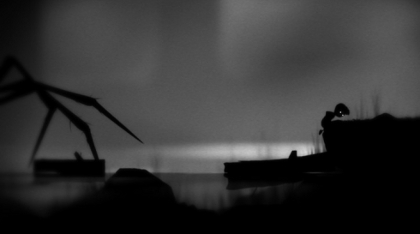If a hunger for sights and sounds is the player’s general motive to forge on, there are more definite incentives in the touches of life and hope that intersperse the scissor-jawed traps, the louring chimneys and electrified surfaces. White butterflies linger over patches of weed; serene, uplifting tones emerge from the ambient score. And of course, there’s the girl, first glimpsed around halfway through – a slight, averted silhouette amid long grass and flecks of light, Limbo’s Princess Peach, the symbolic opposite of decay and predation.
Haunted by these instants of radiance and beauty, it’s easy to aspire beyond Limbo’s fallen realm, easy to look through the shadow of the game’s narrative arch in the telltale repetitions of certain shapes. A stabbing spider’s leg reappears as a mechanical joint, lever-operated by one of your silent adversaries. The enormous, sizzling letters of the word ‘HOTEL’, themselves a metaphor for transience, in-betweenness, must be navigated twice.

The spider is truly loathsome, unfolding its limbs from the darkness in the corners of the screen.
Complaints that the oppressive atmosphere lapses in the game’s latter half fail to account for the way the Dante-esque forest subtly persists, itself a party to the theologically inflected premise of recurrence. Stepping down from a rusting iron ladder, you’ll be surprised by the crush of grass underfoot, and the slant of pine needles in the backdrop. And it’s to the forest that you ultimately, body and soul, return.
The tale winds up in a burst of what seems to be broken glass, the boy tumbling through a wall at the climax of a sequence of bewildering gravity reversals, rolling to lie in the same deathly attitude from which you first roused him, with a tentative tap of A button. Another, final tap reopens his eyes (‘pissholes in the snow’, as AATG’s Richard Horne memorably describes them), and he climbs to his feet, ready to resume his tireless voyage to the right.
On the hillside above, a glimmering. It is the girl. She has her back turned as before, Orpheus-like, hands busy around something in the grass. A ladder dangles from the bough, promising perhaps an ascent of a less physical nature. The boy slowly approaches; is redemption at hand?
She starts. He halts. Darkness falls. The credits fade in. And dawning gradually behind them, the shape of what has been there from the beginning, the menu screen’s shadowy backdrop: the tree, its smooth curves now hung with growths; the ladder, rotten through, one rung dangling; and where the two children stood, two identical columns of flies, busy around something in the grass.

The Stygian boat trip affords a moment of reflection.
Optimistic interpretations of this abrupt, macabre denouement have been proposed. Over at Ars Technica, it has been suggested that the girl and boy ultimately escape Limbo together, abandoning their flesh along with the world itself. The reason, in my opinion, that this view is unsustainable makes its second appearance shortly after the credits. ‘Play’. Within a few seconds of concluding, you can reawaken the protagonist from death, begin the cycle of futility anew. You don’t even have to do this for the implications to hold weight – it’s enough simply to know that the option is there.
Limbo is bookended with death, with corpses underfoot. The intervening chain of events is the player’s failure to realise this fact, or – if he or she is alert to the title’s connotations – to accept it. And the horror of it all is something a game is uniquely gifted to express because a game, unlike any other artform, has ‘replay value’.
A game is an innately ‘purgatorial’ structure, a closed loop of actions and experiences that can be relived, again and again, in different ways, but for that very reason never resolved, doomed eventually to be left in the rot. This is why quibbles over length ring a little hollow. Films and books end; games do not, not as long as the player is obstinate enough to keep going. Playdead has converted this essential attribute into an existential tragedy.





 Satoru Iwata Video Interview - the late Nintendo president spoke with Kikizo in 2004 as 'Nintendo Revolution' loomed.
Satoru Iwata Video Interview - the late Nintendo president spoke with Kikizo in 2004 as 'Nintendo Revolution' loomed. Kaz Hirai Video Interview - the first of Kikizo's interviews with the man who went on to become global head of Sony.
Kaz Hirai Video Interview - the first of Kikizo's interviews with the man who went on to become global head of Sony. Ed Fries Video Interview - one of Xbox's founders discusses an epic journey from Excel to Xbox.
Ed Fries Video Interview - one of Xbox's founders discusses an epic journey from Excel to Xbox. Yu Suzuki, the Kikizo Interview - we spend time with one of gaming's most revered creators.
Yu Suzuki, the Kikizo Interview - we spend time with one of gaming's most revered creators. Tetris - The Making of an Icon: Alexey Pajitnov and Henk Rogers reveal the fascinating story behind Tetris
Tetris - The Making of an Icon: Alexey Pajitnov and Henk Rogers reveal the fascinating story behind Tetris Rare founders, Chris and Tim Stamper - their only interview? Genuinely 'rare' sit down with founders of the legendary studio.
Rare founders, Chris and Tim Stamper - their only interview? Genuinely 'rare' sit down with founders of the legendary studio. The History of First-Person Shooters - a retrospective, from Maze War to Modern Warfare
The History of First-Person Shooters - a retrospective, from Maze War to Modern Warfare
Limbo is a brilliant and memorably experience from start to finish and features the cleverest main-menu screen I’ve ever seen in a game.
I’d also like to make a comparison between it and its XBLA Summer of Arcade stable-mate Hydro Thunder Hurricane. Sure the latter might last 2/3 times as long, but those are hours I wanted back.
I wouldn’t have missed Limbo for the world.
There is something magical about the subtle nods to transience permeating Limbo, and any ending with an openness to interpretation that isn’t ham-fistedly shoehorned in under the pretence of mystery gets my vote for progression.
I didn’t feel robbed by the price, nor the length, and I can’t bring myself to play it again – in the best possible sense.
It was very dark but fun. I enjoyed it but Hydro Thunder Hurricane is more fun overall to me
II’m glad to hear that it’s a small company, that makes me feel better for supporting it. Limbo is a beautiful game with perfectly crafted gameplay. I, however, was very disappointed when the credits rolled in after only playing for 3 hours.
I think I would have been more ok with the short gameplay if it were clear when I bought it. Game reviews rarely disclose the number of hours to complete.